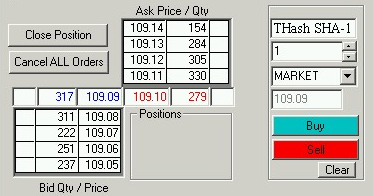Computing Exchange

As you know, competition is the engine of development of any industry, providing the most efficient distribution of resources. Perfect competition in the modern world has survived, perhaps, only in one place - on exchanges.
About what the exchange is and how it differs from the usual market, a lot has been said on Habré. Read, for example, the IPO for dummies series of articles . I only note that standardized goods are traded on the exchange, buyers and sellers compete only in price.
A commodity on the exchange can be anything: grain, metals, currency, securities, etc. In the form of the exchange, as the most fair and convenient, they trade in seo-links, banner displays, electronic currency. So why not trade in what is at the heart of the IT industry — computing resources.
What will be taken as a unit of goods? Several options are possible here. This can be a single floating point operation (1 FLOP). Then the process of selling computing resources will look like this: the seller provides the client with some virtual runtime environment in which a certain amount of memory, processor core, and possibly video card resources are available. At the same time, there is an interface through which the initial data are loaded and the calculation results are returned. The calculations can be performed using any algorithm written in the form of assembler instructions. Another option involves a larger unit of trade, for example, 1 Hash. That is, the algorithm by which the hash will be considered is rigidly set in the software of the exchange's clients. Only the data for calculations and the results change. It does not mean, that the client will have to transmit a huge amount of information. After all, 1 lot on the exchange can be equal to 1 Mhash, the initial data is transmitted in the form of a range of values, and the result reports whether a certain sample string was found among the calculated hashes. This is enough, for example, to implement the mining of those same Bitcoins.
Here the question arises: what will the competition of a computer network constructed in this way and, for example, the Bitcoin network, lead to? The answer may be this: a wider concept does not contradict a narrower one, but includes it in itself and takes it into account as a special case. Thus, if the exchange rate in the global computing network is low, which will allow you to profitably mine Bitcoins, several effects will immediately appear that restore balance. Firstly, an increase in the demand for computing in the global computer network will lead to an increase in the exchange rate, secondly, an increase in the supply of Bitcoins will lead to a drop in the cost of coins, and thirdly, a purely technical mechanism will work, provided for by the Bitcoin network - the network complexity will increase and mining will require more computing resources. But what if the course in the global computer network is this, that mining Bitcoins will not be profitable? This will mean only one thing: new, more interesting projects have appeared, and everyone has switched their resources to them. The same applies to the existing AWS, which, unlike the proposed model, is a simple auction in which only buyers compete, and the seller is only Amazon.
Thus, the economically proposed system is quite stable and dynamic. However, two more problems may arise that are of a socio-ethical nature.
The first is that the created system can be used by attackers to select passwords, RSA keys, etc. But world practice shows that the presence of only the possibility of misuse of any system cannot be a reason for refusing to develop it. After all, there are web hosts, dedicated servers, etc. Their administrators control the use of their resources. And the proposed distributed computing network just does not pretend to be absolute decentralization and anonymity. The exchange is an intermediary in transactions and can verify the integrity of participants.
The second ethical problem is that material benefits can entice those who participated in free distributed computing projects, such as Folding @ home, BOINC, SETI @ home, etc. But, on the other hand, some of these projects have dubious benefits. At the same time, there are many examples in history when purely commercial projects subsequently benefited the public.
As you can see, the idea of creating an exchange of computing resources lies on the surface. Its technical implementation is possible, as existing open (and underground) projects prove. I hope that soon we will have the opportunity to share the resources of our computer for the benefit of society and for ourselves.
